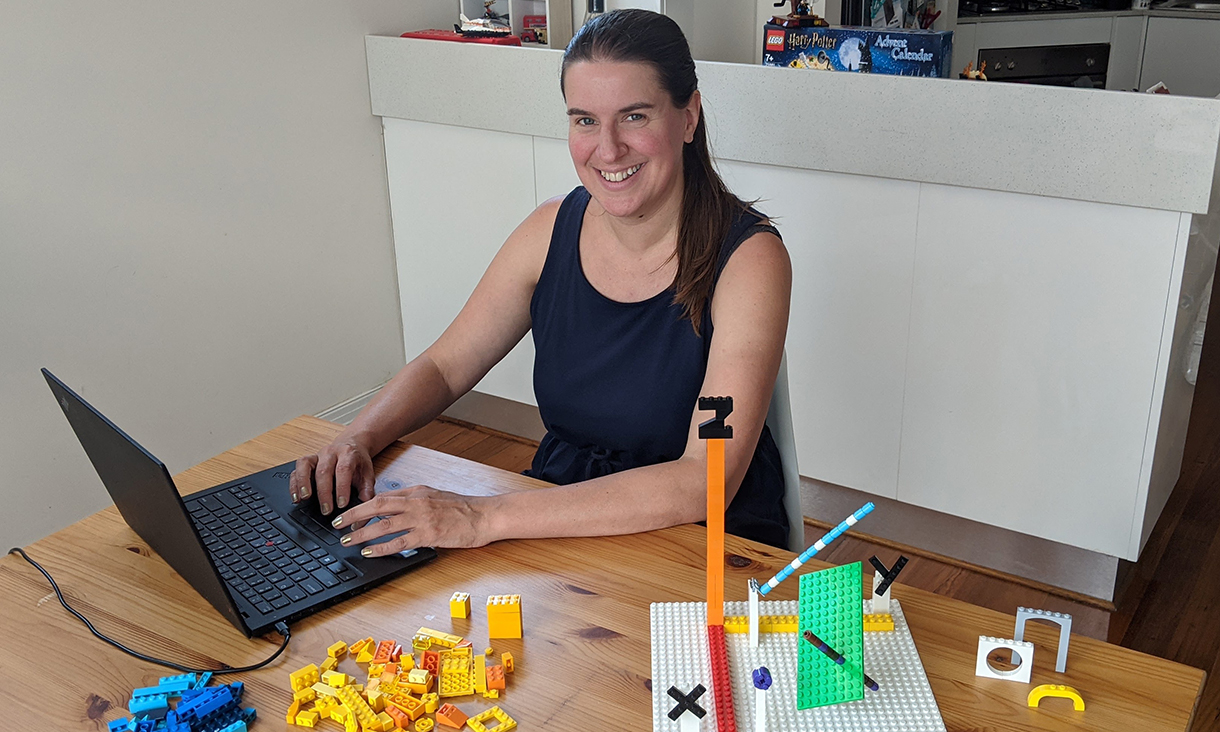Swinburne lecturer creates LEGO stop-motion animations to teach maths

Dr Emily Cook is teaching math problems using LEGO stop-motion animations
In summary
- Senior Lecturer in STEM Education, Dr Emily Cook, creates LEGO stop-motion animation videos to help teach maths to education students
- Using her Adobe Innovation Grant, awarded through Swinburne’s Adobe Creative Campus status, Dr Cook is able to make her videos look more professional
- Dr Cook encourages anyone interested in maths to pursue a career in STEM
Swinburne’s Dr Emily Cook, Senior Lecturer in STEM Education, is creating LEGO stop-motion animation videos to help students solve math problems.
The animations address short problems that are difficult to teach online, as well as long-form questions that require physical models to demonstrate. All of Dr Cook’s fun creations feature a LEGO version of herself completing pun-filled calculations, a variety of maths topics and even animals, such as Adding Vectors (with a duck) and Linear Transformations (with a sheep).
From at-home hobby to professional production
Dr Cook was inspired during her “extreme boredom” in Melbourne’s COVID-19 lockdown last year. While using LEGO to pass the time, she noticed that the matrices she was preparing lectures about looked like LEGO baseplates. From there, the idea struck her to create some new learning resources.
As an Adobe Creative Campus, Swinburne’s Adobe Innovation Grant enabled Dr Cook to purchase filmmaking technology and more LEGO, helping to develop her ideas and give her homemade videos a professional edge.
Despite enjoying the process of making the animations, she admits it is still “painstakingly slow”. Dr Cook storyboards the animation, writes the script, builds the models, performs the animation and edits the videos using Adobe Rush.
She says the animations take an “embarrassingly long time”, with the first two-minute video taking many hours to create.
“It was probably a bit ambitious to start with a problem about a duck swimming across a river. Making the river look good and flow properly without owning enough blue bricks and trying to use the new equipment for the first time was hard!”

Adding Vectors (with a duck)
Maths makes a good impression
The animations have received positive feedback from her friends, family and, most importantly, students. Dr Cook hopes they will be useful to other teachers in the future who find them on YouTube.
Dr Cook began her career in physics, but through tutoring high school maths she found a love for teaching it. Her favourite part of her job at Swinburne is teaching first-year maths units and helping students transition from Year 12 into their university degree.
“Hopefully LEGO makes the compulsory first-year maths unit I teach a little more approachable. The terrible puns have always been part of my teaching style,” she says.

Velocity Vectors (with a turtle)
Inspiring the next generation of women in STEM
As a woman in STEM, Dr Cook says it can be “uncomfortable” being the only woman in the room sometimes and says there are times that she feels like she needs to prove herself.
However, it also gives her the opportunity to inspire other women interested in a career in STEM. For Dr Cook, “Being in a position to be a role model and show young women … that it is possible for women to succeed in STEM and still be themselves," is a real highlight.
She encourages anyone looking to pursue a career in STEM, especially women, to “just go for it”.
“Maths is important as it is used every day, whether or not people realise they are consciously using it. It underpins so many academic courses and careers from science and engineering, to business and design.
“Do what you enjoy and believe in yourself.”
-
Media Enquiries
Related articles
-

- Technology
- Science
- Engineering
Victorian students drive green energy transition through international hydrogen competition
Swinburne’s KIOSC, in collaboration with Horizon Educational and Gippsland Tech School, co-hosted the Hydrogen Grand Prix in Melbourne.Friday 26 July 2024 -

- Technology
- Health
New MedTechVic prototypes to transform everyday lives of people with a disability
Swinburne’s MedTechVic has revealed three new prototypes designed through the joint Health-led Manufacturing Innovation Program, in partnership with the Australian Medtech Manufacturing Centre and Safer Care Victoria
Friday 19 July 2024 -

- Business
- Technology
Swinburne’s Luminate Pitch Night 2024 advances innovative ideas for a better world
Swinburne’s 2024 Luminate Pitch Night showcased market-ready ideas from 10 founders
Wednesday 12 June 2024 -

- Health
- Technology
Clinical Innovation Fellowships develop creative solutions to Australia’s healthcare challenges
MedTechVic is gearing up to begin its fourth year of the Clinical Innovation Fellowship Program (CIFP), following the highly successful third round in 2023.
Wednesday 19 June 2024 -

- Technology
- Aviation
- Sustainability
Swinburne partners with Latrobe City Council to propel Victoria’s Advanced Air Mobility precinct
Swinburne has become the first Foundation Member of the newly established Latrobe Aerospace Technology Precinct.
Friday 03 May 2024

